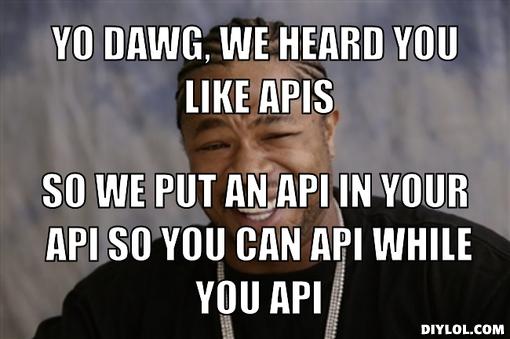Reduce, Reuse… Refactor: Clearer Elixir with the Enum Module
“When an operation cannot be expressed by any of the functions in the Enum module, developers will most likely resort to reduce/3.” From the docs for E...

I’ve been reading a few interesting analyses of Twitter data recently such as this #gamergate analysis by Andy Baio. I thought it would be nice to have a mechanism for people to quickly and easily import data from Twitter to Neo4j for research purposes. Like a good programmer I had to go up at least one level of abstraction. Thus was born the ruby gems neo4apis and neo4apis-twitter (and, incidentally, neo4apis-github just to prove it was repeatable).
Using the neo4apis-twitter gem is easy and can be used either in your ruby code or from the command line. neo4apis takes care of loading your data efficiently as well as creating database indexes so that you can query it effectively.
First you need to make an instance of Neo4Apis::Twitter. Pass in a Neo4j::Session from the neo4j-core gem specify the database to import to:
neo4japis_twitter = Neo4Apis::Twitter.new(Neo4j::Session.open,
import_retweets: true,
import_hashtags: true)
From there we can initialize a client from the twitter gem and import some data:
twitter_client = Twitter::REST::Client.new ...
neo4japis_twitter.batch do
twitter_client.search('ebola', result_type: 'recent').take(100).each do |tweet|
neo4apis_client.import :Tweet, tweet
end
end
This will perform a search using the twitter gem and for each tweet it imports:
Because we set the import_retweets and import_hashtags options to true above, it will also import:
These are all loaded as nodes into the neo4j database and connected with relationships as appropriate.
If you don’t want to bother with writing the ruby code, some commands are provided for you! After installing the gem and setting up the twitter authentication config file (see the README), you just need to perform your search:
neo4apis twitter search "hugs and puppies" 50 --import-retweets --import-hashtags
That will import 50 tweets (and associated users, and retweets, and hashtags, etc…) for the “hugs and puppies” search into neo4j! Note that you can see the documentation for the search command by typing:
neo4apis twitter help search
There is also a command to stream tweets continuously:
neo4apis twitter filter "ballooning etiquette"
Data will be continuously imported until you hit Ctrl-C. Again, for help with this command you can type:
neo4apis twitter help filter
That’s it! You want data? You’ve got data! From there you can just jump right into the awesome Neo4j web console or use the also awesome neo4j and neo4j-core gems to start playing with the data!
“When an operation cannot be expressed by any of the functions in the Enum module, developers will most likely resort to reduce/3.” From the docs for E...
Elixir allows application developers to create very parallel and very complex systems. Tools like Phoenix PubSub and LiveView thrive on this property of the ...
(This post was originally created for the Erlang Solutions blog. The original can be found here)
with It, Can’t Live without It
(This post was originally created for the Erlang Solutions blog. The original can be found here)
I’ve been using Elixir for a while and I’ve implemented a number of GenServers. But while I think I mostly understand the purpose of them, I’ve not gotten t...
I love Lodash, but I’m not here to tell you to use Lodash. It’s up to you to decide if a tool is useful for you or your project. It will come down to the n...
I’ve mix phx.new ed many applications and when doing so I often start with wondering how to organize my code. I love how Phoenix pushes you to think about th...
What can a 50 year old cryptic error message teach us about the software we write today?
For just over a year I’ve been obsessed on-and-off with a project ever since I stayed in the town of Skibbereen, Ireland. Taking data from the 1901 and 1911...
Recently the continuous builds for the neo4j Ruby gem failed for JRuby because the memory limit had been reached. I wanted to see if I could use my favorite...
A while ago my colleague Michael suggested to me that I draw out some examples of how my record linkage algorithm did it’s thing. In order to do that, I’ve ...
Last night I ran a very successful workshop at the Friends of Neo4j Stockholm meetup group. The format was based on a workshop that I attended in San Franci...
In my last two posts I covered the process of importing data from StackOverflow and GitHub for the purpose of creating a combined MDM database. Now we get t...
In my last post I said I would “bring in another data source, show how I linked the data together, and demonstrate the sort of bigger picture that one can ge...
Joining multiple disparate data-sources, commonly dubbed Master Data Management (MDM), is usually not a fun exercise. I would like to show you how to use a g...
I have a bit of a problem.
When using neo4j for the first time, most people want to import data from another database to start playing around. There are a lot of options including LOA...
Having recently become interested in making it easy to pull data from Twitter with neo4apis-twitter I also decided that I wanted to be able to visualize an...
I’ve been reading a few interesting analyses of Twitter data recently such as this #gamergate analysis by Andy Baio. I thought it would be nice to have a ...
I am he as you are he as you are me and we are all together – The Beatles
When I told the people of Northern Ireland that I was an atheist, a woman in the audience stood up and said, ‘Yes, but is it the God of the Catholics or t...
“Wilkins! Yes! I’ve considered decorating these walls with some graffiti of my own, and writing it in the Universal Character.. but it is too depressing...